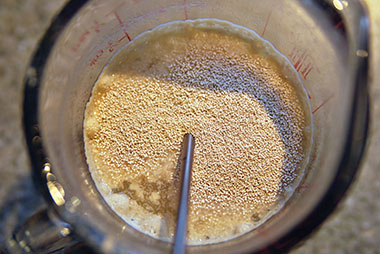
Rehydrating dried yeast is a simple and straightforward process, and one that I find to be essential when using dried yeast for winemaking purposes.
The simple answer to your question is no, do not use distilled water for yeast rehydration. Distilled water is not osmotically balanced, which means that it can actually disrupt the delicate cellular membranes of your developing yeast. Distilled water is just that — distilled. That means that water (could be tap, or from any other source) has been boiled and the resulting steam condensed back into liquid form, leaving any salts, minerals, or other dissolved solids behind.
As such, the water is too clean (free of anything except molecules of hydrogen and oxygen) and since physics dictates that solutes move from an area of high concentration to low concentration, distilled water will essentially push into the cell membrane until some yeast cells burst during the rehydration process or weaken the cellular membrane. The end result could be a loss of viability in your culture, which is the exact opposite of what you want when adding yeast to a fermentation. Less than fully viable yeast increases the chances of sluggish, stuck, or otherwise compromised fermentation, which can lead to not only sweet wine (stuck fermentation) but also a whole host of other wine flaws like increased VA (volatile acidity), acetaldehyde, or ethyl acetate production (smells like oxidized apples and nail polish remover, respectively).
While it might be tempting to use distilled water because it doesn’t contain any chlorine (which can cause TCA or “corked” defects) and if in a closed container is sterile, it may actually be better to use bottled mineral water or even your own home’s tap water, as long as it doesn’t contain any chlorine. If you suspect your water has chlorine, it’s easy to buy faucet-mounted filters from any hardware store or online. Metabisulfite can also be utilized to knock chlorine out of water. If you’re worried about your water containing microbes (i.e., it’s not sterile) you can always boil and then cool your rehydration water before using it.
No matter which water you use, always follow the rehydration protocol for your yeast strain of choice. Most suppliers have directions on their website, if not on the actual packaging. I also like to use a rehydration nutrient, which helps the awakened yeast cells get off to their best start, no matter what the must or juice conditions. An example is Go-Ferm (a Lallemand product sold in the U.S. via Scott Labs). A small amount of the nutrient is dissolved in the warm water you’ll use for hydration. So you can use distilled water if the nutrients are added prior to the yeast. Again, it’s important to follow the manufacturer’s instructions.
Here are some handy conversions for everyone to note (save them somewhere, because you’ll always use them no matter what part of winemaking you’re doing). The internet is also full of handy automatic calculators, but it’s always faster to have some of these memorized so all you have to do is plug them into a calculator and don’t have to be bothered to search online.
1 hL= 100 L
1 L = 1,000 mL = 0.264 U.S. liquid gallon
1 U.S. liquid gallon = 3.785 L = 3,785 mL
1 kg = 1000 g = 2.2 lbs.
1 lb. = 0.454 kg = 454 g
These conversions can make reading between different suppliers and products a little easier. Happy re-hydrating!





